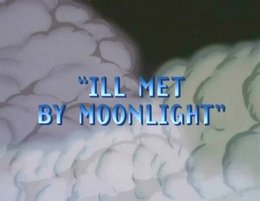Difference between revisions of "Ill Met By Moonlight"
(→Links: ditto) |
m (→Tidbits) |
||
| Line 17: | Line 17: | ||
From the perspective of "faerie-lore," it was also extremely appropriate to make a bell the iron weapon to use against Oberon, since in traditional legend, the faerie-folk feared the sound of bells and would take flight from them. In the original tales about them, this apparently stemmed from the fact that the bells in question were usually church bells and represented the spread of Christianity, overcoming the pagan beliefs that the faeries were connected to; in ''Gargoyles'', however, the bell's effect upon Oberon stems from the fact that it is made out of iron. | From the perspective of "faerie-lore," it was also extremely appropriate to make a bell the iron weapon to use against Oberon, since in traditional legend, the faerie-folk feared the sound of bells and would take flight from them. In the original tales about them, this apparently stemmed from the fact that the bells in question were usually church bells and represented the spread of Christianity, overcoming the pagan beliefs that the faeries were connected to; in ''Gargoyles'', however, the bell's effect upon Oberon stems from the fact that it is made out of iron. | ||
| − | [[Princess Katharine]] believes that vampires and [[weres]] are similarly vulnerable to silver. This provides us with the only solid piece of information about vampires in the ''Gargoyles | + | [[Princess Katharine]] believes that vampires and [[weres]] are similarly vulnerable to silver. This provides us with the only solid piece of information about vampires in the ''Gargoyles'' Universe, although vampires and Dracula were referred to elsewhere in the series (''[[Awakening Part Three]]'', ''The Mirror'', and ''[[The Hound of Ulster]]''). However, it is not known as yet whether Katharine's opinion is correct, or if she was merely repeating a common superstition. |
Alert viewers will note that [[King Arthur]] was already asleep upon [[Avalon]] by the time that Oberon banished the Third Race from Avalon in [[995]], and might wonder why Oberon did not object to his presence the way that he did to the [[Avalon Clan]]'s. According to [[Greg Weisman]], Oberon agreed to admit Arthur to Avalon because he owed [[Merlin]] a favor. (It probably also helped that Arthur would be sleeping in an out-of-the-way place such as the [[Hollow Hill]].) | Alert viewers will note that [[King Arthur]] was already asleep upon [[Avalon]] by the time that Oberon banished the Third Race from Avalon in [[995]], and might wonder why Oberon did not object to his presence the way that he did to the [[Avalon Clan]]'s. According to [[Greg Weisman]], Oberon agreed to admit Arthur to Avalon because he owed [[Merlin]] a favor. (It probably also helped that Arthur would be sleeping in an out-of-the-way place such as the [[Hollow Hill]].) | ||
Revision as of 10:34, 7 September 2007
"Ill Met By Moonlight" is the fifty-fifth televised episode of the series Gargoyles, and the forty-second episode of Season 2.
- Story Editor: Michael Reaves
- Story: Michael Reaves
- Teleplay: Diane Duane & Peter Morwood
- Director: Dennis Woodyard
Summary
Tidbits
This episode is filled with Shakespearean references. Not only do Oberon, Titania, and the Weird Sisters all appear on-stage, but Puck is alluded to, and Ophelia receives her name (borrowed, of course, from Hamlet) for the first time. The episode's title itself is a quote from A Midsummer Night's Dream, Act II, Scene i; appropriately enough, the words are spoken by Oberon to Titania. Oberon says as he prepares to head off after the gargoyles, "The game is afoot," which comes from Henry V's "Once more unto the breach" speech in Henry V, Act III, Scene i (though this line is more commonly associated today with Sherlock Holmes, who quotes it at the beginning of "The Adventure of the Abbey Grange"). And to top it off, Goliath comments at the end, "All's well that ends well, then."
While it had been hinted before in the series that Oberon's Children were vulnerable to iron (The Mirror, City of Stone, Avalon, Cloud Fathers), this is the first time that it is explicitly made clear to the audience. This concept is not an invention of the series, however, but an actual folklore motif; in the legends of the British Isles, at least, the faerie-folk could be driven off by iron objects.
From the perspective of "faerie-lore," it was also extremely appropriate to make a bell the iron weapon to use against Oberon, since in traditional legend, the faerie-folk feared the sound of bells and would take flight from them. In the original tales about them, this apparently stemmed from the fact that the bells in question were usually church bells and represented the spread of Christianity, overcoming the pagan beliefs that the faeries were connected to; in Gargoyles, however, the bell's effect upon Oberon stems from the fact that it is made out of iron.
Princess Katharine believes that vampires and weres are similarly vulnerable to silver. This provides us with the only solid piece of information about vampires in the Gargoyles Universe, although vampires and Dracula were referred to elsewhere in the series (Awakening Part Three, The Mirror, and The Hound of Ulster). However, it is not known as yet whether Katharine's opinion is correct, or if she was merely repeating a common superstition.
Alert viewers will note that King Arthur was already asleep upon Avalon by the time that Oberon banished the Third Race from Avalon in 995, and might wonder why Oberon did not object to his presence the way that he did to the Avalon Clan's. According to Greg Weisman, Oberon agreed to admit Arthur to Avalon because he owed Merlin a favor. (It probably also helped that Arthur would be sleeping in an out-of-the-way place such as the Hollow Hill.)
Links
| << Previous Episode: "Cloud Fathers" | Next Episode: "Future Tense" >> |
